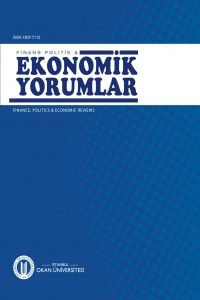İstanbul Menkul Kıymetler Borsası’nda Bankalar Endeksi için Ay Etkisi Üzerine Ampirik Bir Çalışma
Fama (1965, 1970, 1991) tarafindan geliştirilen “Etkin Piyasalar Hipotezi”, menkul kiymet fiyatlarinin ilgili menkul kiymetlere ilişkin tüm bilgileri yansittiğini dolayisiyla piyasada işlem yapan hiçbir yatirimcinin bir takim teknikler kullanarak normalüstü (ortalamadan fazla) getiri elde edemeyeceğini söyler. Bu çalişma, dönemsel anomalilerden en önemlisi sayilabilecek Ocak ayi etkisinin İMKB Bankalar Endeksi’nde gözlenip gözlenmediğini araştirmaktadir. Çalişmada finansal getiri serilerinde siklikla gözlemlenen normal dağilima aykirilik, volatilitenin zaman içerisinde değişim göstermesi gibi ampirik gözlemleri de dikkate alan GARCH modelleri kullanilmaktadir.İnceleme sonucunda Ocak ayi etkisi tespit edilememiştir. Diğer taraftan %5 anlamlilik düzeyinde Şubat, Ağustos, Eylül, Ekim ve Aralik aylarinda oluşan istatistiksel olarak anlamli getirilerin, piyasa etkinliği ve rasyonel fiyatlandirma modeli çerçevesinde piyasa risk faktörü tarafindan açiklanamadiği belirlenmiştir.Getirilerin yilin belirli aylarina bağli bir yapiya sahip olduğunu destekleyen bu çalişmanin sonuçlari, İMKB’de alim-satim kararlarinin zamanlamasi ile riske göre düzeltilmiş getiri elde edilebileceği yönünde yatirimcilara kanitlar sunmaktadir
Anahtar Kelimeler:
Ocak Ayı Etkisi, Anomaliler, İMKB-Bankalar Endeksi
An Empirical Study: Monthly Effects for Istanbul Stock Exchange Banks Indices
Efficient Market Hypothesis developed by Fama (1965,1970,1991) claims that stock prices reflect all available information thus any investor operating in the market cannot provide excess returns using some techniques. This study investigates the existence of January effect, considered one of the most important anomalies, in return series of Banks Indices (XBANK) in Istanbul Stock Exchange Market (ISE). In the review GARCH models are used that takes into account such empirical observations like non-normal distribution and changing volatility which are often observed in financial return series.As a result of the study, January Effect could not be identified. On the other hand, statistically significant returns with a level of 5% confidence observed in months February, August, September and December could not be explained by market efficiency and rational pricing model within the framework determined by the market risk factor. The results of this study support that the returns are acting systematically during certain time periods. And some evidences are presented to the investors for timing decisions of purchase and sales so risk-adjusted returns could be obtained
Keywords:
January Effect, Anomalies, ISE-Banks Indices,
- ISSN: 1307-7112
- Başlangıç: 1963
- Yayıncı: İstanbul Okan Üniversitesi
Sayıdaki Diğer Makaleler
Solvency II (Yükümlülük Karşılama Yeterliliği) Düzenlemeleri ve Türk Sigortacılık Sektörüne Etkileri
Mehmet Akif ÖNCÜ, Muammer MESCİ, Öznur ŞAHİN
Uluslararası Finans Merkezi İstanbul
Zorunlu Karşılık Politikalarının Türk Bankacılık Sektörüne Etkileri
Ayşegül KARABIYIK, Talip SARIÇAM
İpotekli Piyasalarda GSE Modeli; Türkiye için Bir Alternatif Model mi?
İstanbul Menkul Kıymetler Borsası’nda Bankalar Endeksi için Ay Etkisi Üzerine Ampirik Bir Çalışma
